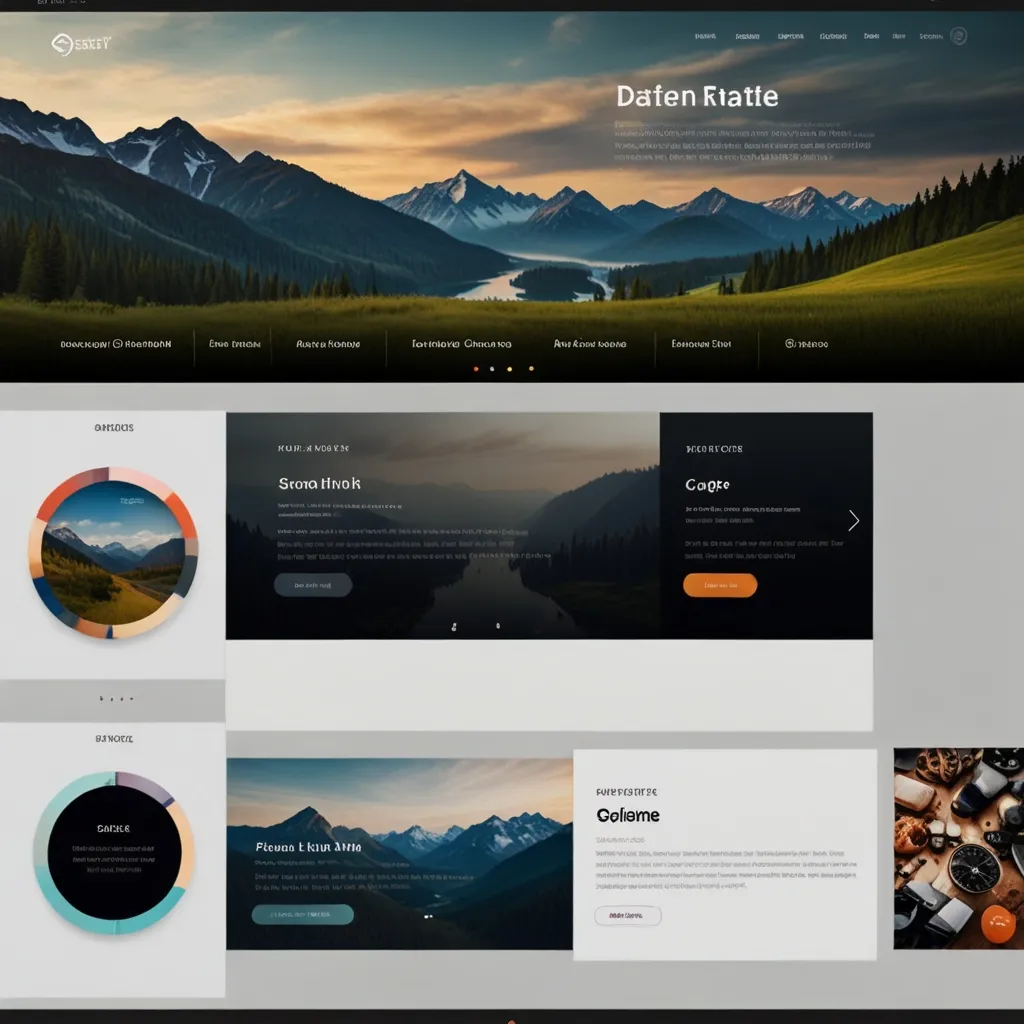JavaScript animation has transformed the web from static pages into dynamic, interactive experiences. As a developer who’s spent years creating animated interfaces, I’ve found these libraries invaluable for building modern web experiences. They enable smooth transitions, complex motion sequences, and visual effects that significantly enhance user engagement.
Animation libraries save considerable development time by abstracting complex calculations and browser inconsistencies. They provide optimized engines that handle timing, easing, and rendering efficiently. This allows developers to focus on creative implementation rather than mathematical intricacies.
The JavaScript animation ecosystem offers options for every project requirement. Let’s explore the most effective libraries and their practical applications.
GSAP (GreenSock Animation Platform)
GSAP stands out as the industry standard for professional web animation. It provides exceptional performance across all browsers and devices while offering precise control over every aspect of animation.
What makes GSAP powerful is its plugin architecture, timeline feature, and robust easing options. It effortlessly animates CSS properties, SVG, canvas, and virtually any JavaScript object property.
// Basic GSAP animation
gsap.to(".box", {
duration: 1,
x: 100,
rotation: 360,
backgroundColor: "#8d44ad",
ease: "back.out(1.7)",
onComplete: () => console.log("Animation completed")
});
// Creating a timeline for sequence control
const tl = gsap.timeline({defaults: {duration: 0.5}});
tl.to(".box1", {x: 100})
.to(".box2", {y: 50}, "-=0.3") // Overlap previous animation by 0.3s
.to(".box3", {rotation: 45})
.to(".box4", {scale: 1.5});
// Responsive animation with matchMedia
const mm = gsap.matchMedia();
mm.add("(min-width: 800px)", () => {
gsap.to(".responsive-element", {x: 200});
});
mm.add("(max-width: 799px)", () => {
gsap.to(".responsive-element", {x: 50});
});
GSAP’s ScrollTrigger plugin has revolutionized scroll-based animations:
// ScrollTrigger example
gsap.registerPlugin(ScrollTrigger);
gsap.to(".parallax-element", {
y: 300,
scrollTrigger: {
trigger: ".section",
start: "top center",
end: "bottom center",
scrub: true,
markers: true // For development
}
});
Three.js
Three.js opens up 3D animation possibilities in browsers. It abstracts WebGL complexity, making 3D programming accessible to web developers.
// Basic Three.js scene setup
const scene = new THREE.Scene();
const camera = new THREE.PerspectiveCamera(75, window.innerWidth / window.innerHeight, 0.1, 1000);
const renderer = new THREE.WebGLRenderer();
renderer.setSize(window.innerWidth, window.innerHeight);
document.body.appendChild(renderer.domElement);
// Creating a cube
const geometry = new THREE.BoxGeometry();
const material = new THREE.MeshBasicMaterial({color: 0x00ff00});
const cube = new THREE.Mesh(geometry, material);
scene.add(cube);
camera.position.z = 5;
// Animation loop
function animate() {
requestAnimationFrame(animate);
cube.rotation.x += 0.01;
cube.rotation.y += 0.01;
renderer.render(scene, camera);
}
animate();
Three.js supports loading 3D models, creating particles, implementing physics, and much more:
// Loading a 3D model
const loader = new THREE.GLTFLoader();
loader.load('path/to/model.glb', (gltf) => {
const model = gltf.scene;
scene.add(model);
}, undefined, (error) => {
console.error('Error loading model:', error);
});
// Creating particle system
const particles = new THREE.BufferGeometry();
const count = 5000;
const positions = new Float32Array(count * 3);
for (let i = 0; i < count * 3; i++) {
positions[i] = (Math.random() - 0.5) * 10;
}
particles.setAttribute('position', new THREE.BufferAttribute(positions, 3));
const particleMaterial = new THREE.PointsMaterial({
size: 0.05,
color: 0xffffff
});
const particleSystem = new THREE.Points(particles, particleMaterial);
scene.add(particleSystem);
Anime.js
Anime.js offers a lightweight yet powerful approach to animation. Its declarative API makes creating complex animations straightforward.
// Basic animation
anime({
targets: '.element',
translateX: 250,
rotate: '1turn',
backgroundColor: '#FFC0CB',
duration: 800,
easing: 'easeInOutQuad'
});
// Staggered animations
anime({
targets: '.staggered-element',
translateY: [
{value: 100, duration: 500},
{value: 0, duration: 500}
],
delay: anime.stagger(100),
loop: true
});
// Timeline for sequence control
const timeline = anime.timeline({
easing: 'easeOutExpo',
duration: 750
});
timeline
.add({
targets: '.step1',
scale: [0, 1]
})
.add({
targets: '.step2',
translateX: 250
})
.add({
targets: '.step3',
opacity: 1
});
Anime.js excels at animating SVG elements:
// SVG path animation
anime({
targets: '.svg-path',
strokeDashoffset: [anime.setDashoffset, 0],
easing: 'easeInOutSine',
duration: 1500,
delay: function(el, i) { return i * 250 },
direction: 'alternate',
loop: true
});
Motion One
Motion One is a newer library built on the Web Animations API. It provides a cleaner, more modern approach to animation with smaller bundle size.
// Basic animation
import { animate } from "motion";
animate(".box",
{ x: 100, opacity: 1 },
{ duration: 1, easing: "ease-in-out" }
);
// Keyframes animation
animate(".element",
{
transform: [
"scale(1) rotate(0deg)",
"scale(1.2) rotate(45deg)",
"scale(1) rotate(90deg)"
]
},
{ duration: 2, repeat: Infinity }
);
// Scroll-linked animations
import { animate, scroll } from "motion";
scroll(
animate(".parallax-image", { y: [0, 200] }),
{ target: document.querySelector(".container") }
);
Motion One also supports spring animations for more natural motion:
import { animate, spring } from "motion";
animate(".bounce-element",
{ scale: 1.2 },
{
duration: 0.5,
easing: spring({ stiffness: 100, damping: 5 })
}
);
Lottie
Lottie bridges the gap between design tools and code by enabling the use of After Effects animations directly in web projects.
// Basic Lottie implementation
import lottie from 'lottie-web';
const animation = lottie.loadAnimation({
container: document.querySelector('#lottie-container'),
renderer: 'svg',
loop: true,
autoplay: true,
path: 'data.json' // JSON file exported from After Effects
});
// Control methods
document.querySelector('#play-button').addEventListener('click', () => {
animation.play();
});
document.querySelector('#pause-button').addEventListener('click', () => {
animation.pause();
});
document.querySelector('#speed-control').addEventListener('input', (e) => {
animation.setSpeed(parseFloat(e.target.value));
});
Lottie animations can also be interactive:
// Interactive animation
const interactiveAnimation = lottie.loadAnimation({
container: document.querySelector('#interactive-animation'),
renderer: 'svg',
loop: false,
autoplay: false,
path: 'interactive-data.json'
});
// Control animation based on scroll position
let scrollPosition = 0;
const animationLength = interactiveAnimation.totalFrames;
window.addEventListener('scroll', () => {
scrollPosition = window.scrollY / (document.body.offsetHeight - window.innerHeight);
const frameNumber = Math.floor(scrollPosition * animationLength);
interactiveAnimation.goToAndStop(frameNumber, true);
});
Popmotion
Popmotion focuses on functional, composable animations with physics-based motion.
import { animate, spring, inertia } from 'popmotion';
// Spring animation
const springAnimation = animate({
from: 0,
to: 100,
type: 'spring',
stiffness: 200,
damping: 15,
onUpdate: (value) => {
document.querySelector('.box').style.transform = `translateX(${value}px)`;
}
});
// Inertia (momentum scrolling)
let currentY = 0;
let velocity = 0;
document.addEventListener('touchmove', (e) => {
const newY = e.touches[0].clientY;
velocity = newY - currentY;
currentY = newY;
});
document.addEventListener('touchend', () => {
inertia({
from: currentY,
velocity: velocity,
friction: 0.9,
onUpdate: (y) => {
document.querySelector('.scrollable').style.transform = `translateY(${y}px)`;
currentY = y;
}
});
});
Practical Applications
I’ve found these libraries particularly effective for specific scenarios:
For product showcases, GSAP combined with ScrollTrigger creates impressive reveal animations:
// Product showcase animation
gsap.registerPlugin(ScrollTrigger);
const sections = document.querySelectorAll('.product-section');
sections.forEach(section => {
const image = section.querySelector('.product-image');
const details = section.querySelector('.product-details');
gsap.timeline({
scrollTrigger: {
trigger: section,
start: "top 70%",
end: "bottom 20%",
toggleActions: "play none none reverse"
}
})
.from(image, {
x: -100,
opacity: 0,
duration: 0.8
})
.from(details, {
x: 100,
opacity: 0,
duration: 0.8
}, "-=0.6");
});
For data visualization, combining D3.js with animation libraries creates engaging charts:
// Animated bar chart with D3 and GSAP
const svg = d3.select('#chart')
.append('svg')
.attr('width', 800)
.attr('height', 400);
d3.json('data.json').then(data => {
const bars = svg.selectAll('rect')
.data(data)
.enter()
.append('rect')
.attr('x', (d, i) => i * 50)
.attr('y', 400)
.attr('width', 40)
.attr('height', 0)
.attr('fill', d => d.color);
gsap.to(bars.nodes(), {
y: d => 400 - d.__data__.value * 2,
height: d => d.__data__.value * 2,
duration: 1.5,
ease: "elastic.out(1, 0.3)",
stagger: 0.1
});
});
For interactive storytelling, combining multiple libraries creates immersive experiences:
// Interactive story scene transition
function transitionToScene(currentScene, nextScene) {
// Fade out current scene
gsap.to(currentScene, {
opacity: 0,
duration: 0.5,
onComplete: () => {
currentScene.style.display = 'none';
nextScene.style.display = 'block';
// Load and play Lottie animation for next scene
const sceneAnimation = lottie.loadAnimation({
container: nextScene.querySelector('.scene-animation'),
renderer: 'svg',
loop: false,
autoplay: true,
path: nextScene.dataset.animation
});
// Animate in scene elements
const elements = nextScene.querySelectorAll('.animate-in');
gsap.from(elements, {
y: 50,
opacity: 0,
duration: 0.8,
stagger: 0.2,
ease: "back.out(1.7)"
});
}
});
}
Performance Considerations
Animation performance is critical for smooth user experiences. I’ve developed these practical guidelines:
-
Use transforms and opacity for animations when possible as they’re GPU-accelerated.
-
Implement animation throttling for lower-powered devices:
// Performance-aware animation
const performanceMode = window.matchMedia('(prefers-reduced-motion: reduce)').matches ||
!window.devicePixelRatio ||
window.devicePixelRatio < 1.5;
// Adjust animation settings based on device capabilities
gsap.to('.element', {
x: 100,
duration: performanceMode ? 0.1 : 1, // Shorter or no animation for low-performance devices
ease: performanceMode ? "none" : "power2.out"
});
- Use requestAnimationFrame for custom animations:
// Efficient custom animation loop
let animationId;
let progress = 0;
function animate() {
progress += 0.01;
if (progress >= 1) {
progress = 1;
cancelAnimationFrame(animationId);
return;
}
// Apply easing
const easedProgress = 1 - Math.pow(1 - progress, 3); // Cubic ease-out
// Update DOM
element.style.transform = `translateX(${easedProgress * 100}px)`;
animationId = requestAnimationFrame(animate);
}
animationId = requestAnimationFrame(animate);
- Monitor performance with browser tools:
// Performance monitoring
const performanceObserver = new PerformanceObserver((list) => {
const entries = list.getEntries();
entries.forEach((entry) => {
if (entry.entryType === 'frame' && entry.duration > 16.67) { // Over 60fps threshold
console.warn('Animation frame drop detected:', entry.duration);
// Implement fallback or simplified animation
}
});
});
performanceObserver.observe({entryTypes: ['frame']});
Choosing the Right Library
Selecting the appropriate animation library depends on project requirements:
For complex, timeline-based animations with precise control, GSAP is the best choice.
For 3D experiences, Three.js provides the most comprehensive solution.
For lightweight needs with simple API, Anime.js offers an excellent balance.
For modern projects focused on performance, Motion One provides a forward-looking approach.
For implementing designer-created animations, Lottie bridges the design-development gap.
For physics-based, natural-feeling motion, Popmotion delivers elegant solutions.
Creating Accessible Animations
I always ensure my animations are accessible by following these guidelines:
// Respecting user preferences
const prefersReducedMotion = window.matchMedia('(prefers-reduced-motion: reduce)').matches;
function createAccessibleAnimation() {
if (prefersReducedMotion) {
// Skip animation or provide minimal version
element.style.transform = 'translateX(100px)'; // Apply end state immediately
} else {
// Full animation
gsap.to(element, {
x: 100,
duration: 1,
ease: "power2.out"
});
}
}
// Pause animations when tab is inactive
document.addEventListener('visibilitychange', () => {
if (document.hidden) {
gsap.globalTimeline.pause();
} else {
gsap.globalTimeline.resume();
}
});
JavaScript animation has evolved from simple effects to sophisticated motion systems. These libraries have democratized animation, making complex motion accessible to developers of all skill levels. By choosing the right tool and focusing on performance and accessibility, we can create web experiences that feel responsive, intuitive, and delightful.
The future of web animation continues to advance with improving browser capabilities, WebGPU, and increasingly sophisticated tools. As developers, our responsibility is to harness these powerful libraries thoughtfully, creating animations that enhance rather than distract from the user experience.






